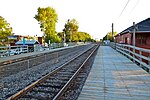CKVL-FM
2008 establishments in QuebecCommunity radio stations in CanadaFrench-language radio stations in QuebecQuebec radio station stubsRadio stations established in 2008 ... and 1 more
Radio stations in Montreal

CKVL-FM (FM 100,1 Radio LaSalle) is a community radio station located in Montreal, Quebec, Canada, broadcasting at 100.1 MHz. The station is owned and operated by La radio communautaire de Ville LaSalle, a non-profit organization. The station primarily serves the Montreal borough of Lasalle, which is also the location of their studios and transmitter. Most of the station's programming is in French; however, the station is also authorized to use English.The station is a member of the Association des radiodiffuseurs communautaires du Québec.
Excerpt from the Wikipedia article CKVL-FM (License: CC BY-SA 3.0, Authors, Images).CKVL-FM
Rue Riverview, Montreal LaSalle
Geographical coordinates (GPS) Address Nearby Places Show on map
Geographical coordinates (GPS)
| Latitude | Longitude |
|---|---|
| N 45.428333333333 ° | E -73.661111111111 ° |
Address
Hôtel de ville de Ville LaSalle
Rue Riverview
H8R 1Z8 Montreal, LaSalle
Quebec, Canada
Open on Google Maps










